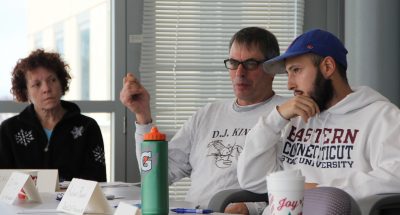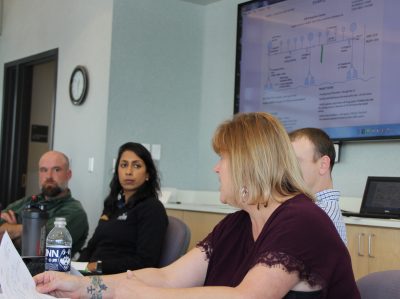
About 25 federal and state regulators met with current and aspiring kelp farmers at UConn’s Avery Point campus on Dec. 14 to exchange information and concerns about permitting for gear used for commercial seaweed farming in Long Island Sound.
Anoushka Concepcion, assistant aquaculture extension educator at CT Sea Grant, organized the meeting as the first to bring representatives of the various federal and state agencies together with kelp growers to hash out regulatory issues facing this emerging industry. While this session focused specifically on the long lines, anchors, buoys and other equipment used in seaweed farms that lease growing areas in the Sound, she anticipates future meetings will address other issues.
“We want to expand kelp aquaculture in Connecticut and the region,” she told the group at the start of the meeting.
“But how can we do that,” she asked, while also minimizing conflicts with boaters and sea turtles, Atlantic sturgeon and other protected species.
Participating agencies included the National Oceanic and Atmospheric Administration Fisheries division; the U.S. Army Corps of Engineers; the fisheries,

boating and aquaculture permitting divisions of the state Department of Energy and Environmental Protection and the state Bureau of Aquaculture. In preparation for the meeting, kelp farmers were surveyed about their practices, including when they deploy gear and harvest seaweed, and whether the current November-through-May season should be extended.
Cori Rose, senior project manager for the U.S. Army Corps of Engineers, which grants permits for offshore structures including seaweed gear arrays, said kelp is being grown on 51 acres in Long Island Sound, and permit applications have been submitted for 65 additional acres.
“We have to try to balance all the uses of Long Island Sound, to make sure everyone gets fair use,” she said.
J.P. Velllotti of East Coast Kelp Farms said the seaweed that can be grown in Connecticut waters is best suited for high-end specialty food markets. Once harvested, he noted, kelp has “zero shelf life” as a fresh product, and must be blanched and frozen or dried and packaged to be a saleable product.
“We’re going to develop a culinary kelp that’s young and tender, a limited quantity type of product,” he said.
